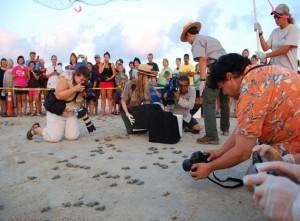Following the Deepwater Horizon Oil Spill, the Natural Resource Damage Assessment Trustees have employed a diverse array of tactics to study the health of sea turtles. As part of work to assess the spill's harm to natural resources and services they provide, the trustees have augmented and expanded several long-running investigations on the Kemp's ridley turtle.
The Kemp's ridley work is expected to be particularly helpful because an extensive pre-spill database of Kemp's ridley research provides an important source of baseline information for comparison to post-spill data as part of the Natural Resource Damage Assessment.
Sea turtle assessment activities at nesting sites in Texas are currently ongoing and include field and laboratory tests to determine oil-related exposure. In addition, scientists are fitting adult turtles with satellite transmitters to help assess the Kemp's ridley exposure to and injury resulting from Deepwater Horizon oil.
On June 28, 2012, local news reporters were among those offered a look at the ongoing research at Padre Island National Seashore by the Texas Parks and Wildlife Department, U.S. Fish and Wildlife Service and the National Park Service. Several hundred people watched the release of sea turtle hatchlings next to the Malaquite Visitor Center. The 94 baby turtles flapped and paddled across wet sand as park rangers kept the curious public and hungry sea gulls at a safe distance. The hatchlings were the survivors from a clutch that included 108 eggs.
As critical as the lively hatchlings are to survival of this endangered species, it is the eggs that did not hatch and the embryos they contain that are important to NRDA researchers. Donna Shaver, PhD, chief of the National Park Service Sea Turtle Science and Recovery Division, escorted reporters and photographers to the park's laboratory to see how 14 unhatched eggs would make their contributions to NRDA. Under special lighting, skilled lab technicians took blood and tissue samples from the embryos to be analyzed for evidence of oil exposure.
During the nesting season, 10 adult female turtles that came ashore to nest were fitted with satellite transmitters so researchers could track their movement. Satellite tracking of the Kemp's ridleys began in 1997 in an effort to promote the recovery of a species from the brink of extinction. This historical monitoring revealed that after the nesting season, most of the tracked turtles left south Texas and traveled northward, parallel to the coast, with their last identified location in the northern or eastern Gulf of Mexico. Recent tracking data shows similar migratory habits.
"The area off the coast of Louisiana has a high concentration of foraging females," noted Shaver. Collection and analysis of NRDA data is ongoing and will be used to determine the liability of responsible parties for injury to endangered sea turtles as well as their habitats and prey.
News reports about the June 28 Kemp's ridley release included coverage by MySanAntonio.com, KIIITV, KRISTV, the Houston Chronicle, the Corpus Christi Caller and Austin Culture Map. To follow the movements of sea turtles being tracked with satellite transmitters, visit www.seaturtle.org/tracking and select Padre Island National Seashore Kemp's Ridley Tracking Program-2012.
This site includes maps and data showing the movements of 10 turtles tagged with satellite transmitters.


